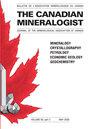伊朗东北部和南部Neyshabour和Meydook矿绿松石族固溶体的电子探针研究
IF 1.5
4区 地球科学
Q3 MINERALOGY
引用次数: 1
摘要
绿松石,CuAl6(PO4)4(OH)8·4H2O,属于绿松石类,由绿松石、硫铁石、亚绿柱石、浮石、planerite和UM1981-32-PO:FeH组成。为了研究Neyshabour和Meydook矿山样品中的绿松石族固溶体,选择了17个样品,并使用电子探针微量分析进行了研究。此外,还对它们的主要成分进行了比较,以评估区分波斯绿松石来源的可行性。电子探针数据表明,所研究的样品不是由纯绿松石(或任何其他纯端基)组成的,从化学角度来看,属于绿松石族固溶体。在绿松石-天青石-黄铜矿-未知矿物第四纪固溶体图中,分析样品的化学成分沿绿松石–天青石线分布,黄铜矿和未知矿物的参与程度较小。在来自两个研究区域的色调和饱和度不同的浅蓝色样本中,与来自奈沙布尔的样本相比,来自梅多克的样本中的planerite更丰富。然而,并不是所有的浅蓝色样品都是天青石。本研究表明,基于电子探针微量分析方法和本构主元素来区分等色蓝绿绿柱石的成因矿床是不可能的。本文章由计算机程序翻译,如有差异,请以英文原文为准。
Electron microprobe study of turquoise-group solid solutions in the Neyshabour and Meydook mines, northeast and southern Iran
Turquoise, CuAl6(PO4)4(OH)8·4H2O, belongs to the turquoise group, which consists of turquoise, chalcosiderite, aheylite, faustite, planerite, and UM1981-32-PO:FeH. In order to study turquoise-group solid solutions in samples from the Neyshabour and Meydook mines, 17 samples were selected and investigated using electron probe microanalysis. In addition, their major elements were compared in order to evaluate the feasibility of distinguishing the provenance of Persian turquoises. The electron microprobe data show that the studied samples are not constituted of pure turquoise (or any other pure endmember) and belong, from the chemical point of view, to turquoise-group solid solutions.
In a turquoise–planerite–chalcosiderite–unknown mineral quaternary solid solution diagram, the chemical compositions of the analyzed samples lie along the turquoise–planerite line with minor involvement of chalcosiderite and the unknown mineral. Among light blue samples with varying hues and saturations from both studied areas, planerite is more abundant among samples from Meydook compared with samples from Neyshabour. Nevertheless, not all the light blue samples are planerite. This study demonstrates that distinguishing the deposit of origin for isochromatic blue and green turquoises, based on electron probe microanalysis method and constitutive major elements, is not possible.
求助全文
通过发布文献求助,成功后即可免费获取论文全文。
去求助
来源期刊

Canadian Mineralogist
地学-矿物学
CiteScore
2.20
自引率
22.20%
发文量
45
审稿时长
4-8 weeks
期刊介绍:
Since 1962, The Canadian Mineralogist has published papers dealing with all aspects of mineralogy, crystallography, petrology, economic geology, geochemistry, and applied mineralogy.
 求助内容:
求助内容: 应助结果提醒方式:
应助结果提醒方式:


